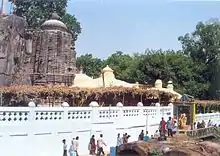Patna State
Patna State was a princely state in the Eastern States Agency of India during the British Raj. It had its capital at Balangir. Its area was 6,503 km2 (2,511 sq mi).[1]
| Patna State | |||||||
|---|---|---|---|---|---|---|---|
| Princely State of British India | |||||||
| 1360–1948 | |||||||
 Patna and Karond (Kalahandi) State in the Imperial Gazetteer of India | |||||||
| Area | |||||||
• 1892 | 6,503 km2 (2,511 sq mi) | ||||||
| Population | |||||||
• 1892 | 257,959 | ||||||
| History | |||||||
| History | |||||||
• Established | 1360 | ||||||
| 1948 | |||||||
| |||||||
| Indian Princely States K-W | |||||||
History
The foundation of the Patna kingdom was laid by Ramai Deva of the Chauhan dynasty in 1360 CE when he overthrew Hattahamir Deb, the administrator of the region as the Eastern Ganga Empire started weakening following invasions from the northern part of the subcontinent.[2][3][4][5] The Chauhan reign eventually extends over the region under its cadet branches which include the kingdoms of Sambalpur State, Sonepur State and the zamindaries of Khariar and Jarasingha.[6] The history of the Chauhan rule in the region is also obtained from the 16th century palm-leaf manuscript Kosalananda Kavya.[7]
After Indian independence, Patna's last ruler Rajendra Narayan Singh Deo acceded to the newly independent Dominion of India, on 1 January 1948 with the state forming much of the present day Balangir district. Rajendra Narayan Singh Deo, built a new career as an elected politician and served as Chief Minister of Orissa from 8 March 1967 to 9 January 1971.[1]
Rulers
The rulers of Patna state of the Chauhan Dynasty:[8][9]
- Ramai Deva (1360–1380)
- Mahalinga Deva (1380–1385)
- Vatsaraja Deva (1385–1410)
- Vaijala Deva I (1410–1430)
- Bhojaraj Deva (1430–1455)
- Pratap Rudra Deva I (1455–1480)
- Bhupal Deva I (1480–1500)
- Vikramaditya Deva I (1500–1520)
- Vaijal Deva II (1520–1540)
- Bajra Hiradhara Deva (1540–1570)
- Narsingh Deva (1570–1577)
- Hamir Deva (1577–1581)
- Pratap Deva II (1581–1620)
- Vikramaditya Deva II (1620–1640)
- Mukunda Deva (1640–1670)
- Balaram Deva (1670–1678)
- Hrdesha Deva (1678–1685)
- Rai Singh Deva (1685–1762)
- Prithviraj Deva (1762–1765)
- Ramchandra Singh Deo I (1765–1820)
- Bhupal Singh Deo (1820–1848)
- Hiravajra Singh Deo (1848–1866)
- Pratap Singh Deo (1866–25 November 1878)
- Ramchandra Singh Deo II (25 November 1878-1895)
- Lal Dalganjan Singh Deo (1895–1910)
- Prithviraj Singh (1910–1924)
- Rajendra Narayan Singh Deo (1924–1 January 1948)
Titular
- Rajendra Narayan Singh Deo (1 January 1948 to 23 February 1975)
- Rajraj Singh Deo (23 February 1975 to April 2004)
- Kanak Vardhan Singh Deo (April 2004 – current)
Gallery


 Nrusinghanath Temple entrance
Nrusinghanath Temple entrance
References
- "Patna (Princely State)". Archived from the original on 22 May 2009. Retrieved 22 May 2010.
- ODISHA DISTRICT GAZETTEERS BOLANGIR (PDF), GAD, Govt of Odisha, 1994, p. 55-65
- ODISHA DISTRICT GAZETTEERS DEOGARH (PDF), GAD, Govt of Odisha, 1994, p. 17-19
- "WESTERN ORISSA ON THE EVE OF CHAUHAN RULE" (PDF). www.shodhganga.inflibnet.ac.in. Retrieved 9 September 2017.
- "CHAUHAN RULERS OP PATNA STATE" (PDF). www.shodhganga.inflibnet.ac.in. Retrieved 9 September 2017.
- Brundaban Mishra (2012), Social Structure Of Western Orissa Under The Chauhans Of Sambalpur, JHSS, retrieved 10 March 2021
- Ashok kumar Patnaik (December 2009), The Mirror Reflection of Sambalpur State through the Courtly Chronicle called Kosalananda Kavyam, Odisha History Congress, retrieved 12 March 2021
- Raghumani Naik (3 March 2018), GENEALOGICAL ANALYSIS OF CHAUHAN RULERS OF PATNAGARH IN WESTERN ORISSA: A STUDY, IRJHRSS, retrieved 12 March 2021
- "Patna Princely State (9 gun salute)". Archived from the original on 13 September 2017. Retrieved 17 June 2014.